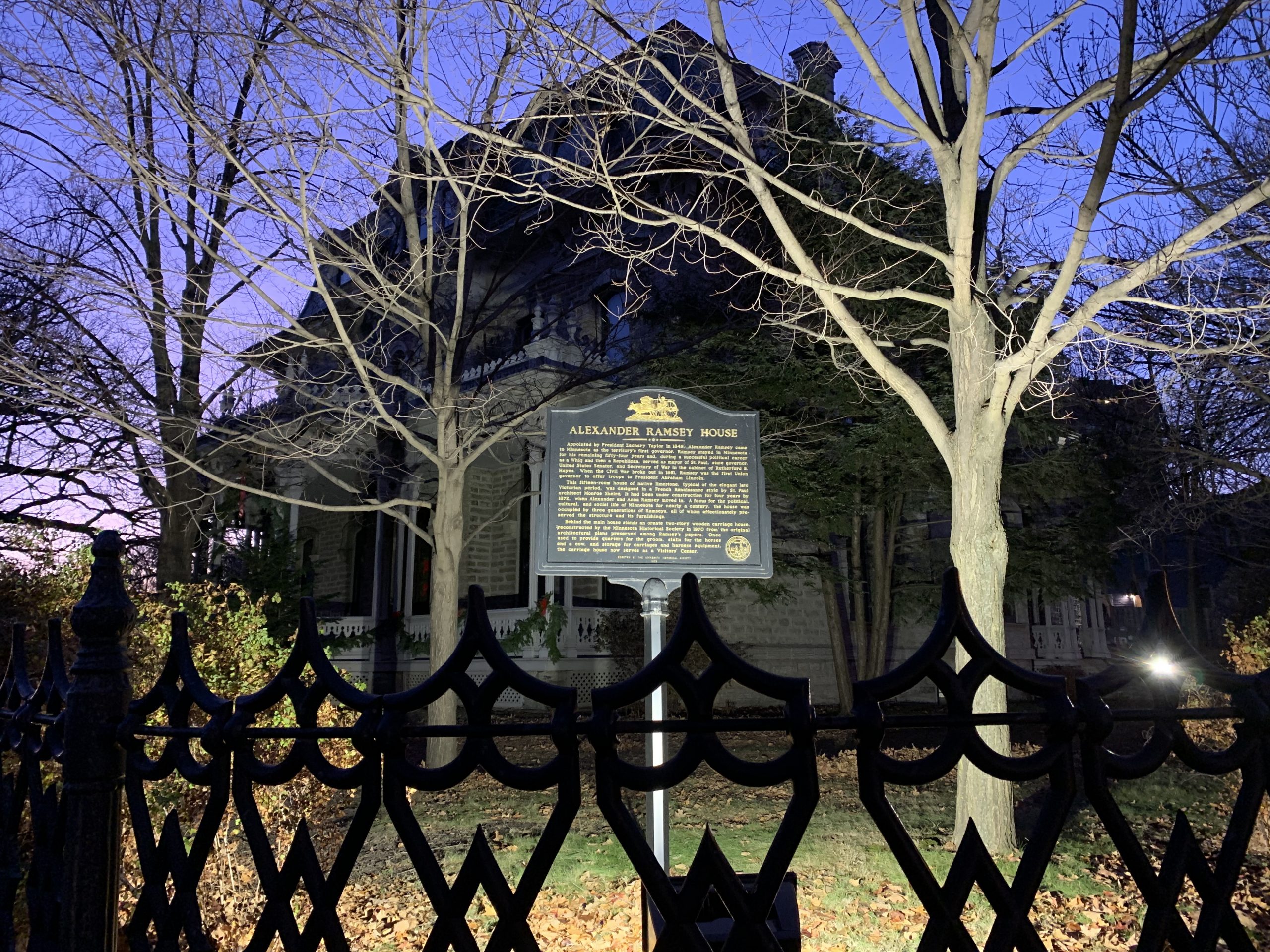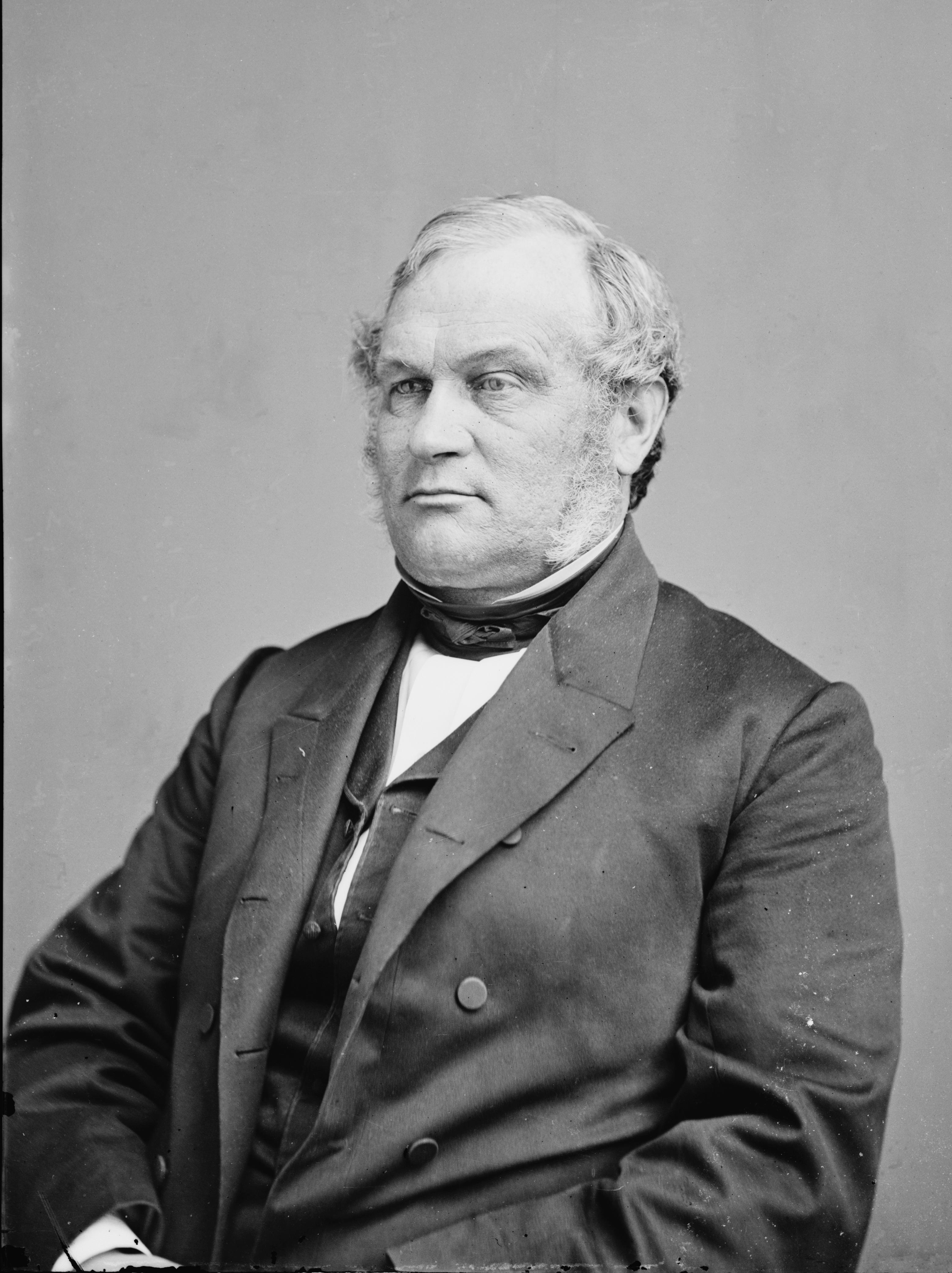
(From Wikipedia.org)
Alexander Ramsey was the first territorial governor of Minnesota and the second governor after it gained its statehood. Ramsey was very involved with the US military during his political career. He is notable for his involvement in the Dakota War of 1862, being the first governor to lend troops for the Civil War effort and becoming the Secretary of War under President Hayes. The Alexander Ramsey House was built from 1868 to 1872 and was owned by Ramsey until his death in 1903. Today, it serves as a museum to one of the most influential men in Minnesotan history.
Early Life and Minnesota’s Founding
Alexander Ramsey was born and grew up in Pennsylvania, in 1815. His father, Thomas, lived an ordinary life but was highly respected for his honor. However, after he had fallen upon hard times, he committed suicide when Ramsey was ten. After Thomas Ramsey’s death, the Ramsey family was broken up, and Alexander was sent to live with his mother’s brother in Harrisburg. While in Harrisburg, Ramsey went to school and assisted his uncle as a carpenter. Ramsey also engaged with a local historian and became instilled with a love for books. He later went to college to become a carpenter but dropped his trade to begin a career in law. After a short law career, he entered politics becoming a member of the United States House of Representatives for the state of Pennsylvania. Ramsey served two terms as a congressman and was then chosen as chairman of the Whig state central committee. In his position, Ramsey greatly helped Whig presidential candidate, Zachary Taylor, take the state of Pennsylvania [6] in the election of 1848. In return, the newly elected president rewarded Ramsey with the governorship of the new territory of Minnesota. Ramsey left Pennsylvania in May 1949 and became the first governor of the territory of Minnesota [7].
When Ramsey first arrived in MN, there were only 6,000 white settlers living in the territory [7]. Of these many were traders that would conduct business with both the Ojibwe tribe and the Sioux tribe. The territory had only two forts, Fort Snelling and Fort Gaines, that served to protect inhabitants and prevent war with the two tribes. A total of only 317 soldiers were divided among the two forts upon Ramsey’s arrival. When Ramsey first arrived in St. Paul, he was greeted by Henry Sibley, “the man that had been largely instrumental in achieving territorial status for Minnesota” [8]. Sibley, a democrat, would have obtained the governorship had Taylor’s predecessor, James Polk, been able to pass the bill that gave Minnesota its status as a territory before Polk’s term ended. Even though they had a stark political difference, Sibley and Ramsey became staunch friends focusing only on the advancement of Minnesota [7]. Ramsey, with the help of Sibley, heavily focused on expanding the transportation and communication passages throughout the territory. As early as the 1850, Ramsey sought to create a telegraph network spanning the Mississippi River from St Paul to Prairie du Chien in present day Wisconsin. Ramsey’s intent was to build up the territory enticing more settlers from the East to come and help grow the Minnesota economy.
In the later parts of Ramsey’s stint as territorial governor, the number of settlers from the East grew rapidly in spite of limited methods of communication and transportation. The increase of settlers quickly became a problem when many of these Easterners began moving into Indian territory. In response Ramsey was made the superintendent of Indian Affairs for the territory to help ease tensions. Ramsey spent much of his time communicating and even reconciling with various tribes. However, Ramsey still wanted many of the new settlers to inhabit the rich agricultural lands currently in possession of the two tribes. Ramsey eventually lost his power when in 1852, Franklin Pierce, a democrat, was elected and Willis Gorman was appointed to take Ramsey’s place. Throughout the end of Ramsey’s time as territorial governor, he continued to negotiate with the Sioux tribe in attempt to buy lands west of the Mississippi. These talks led to treaties with both the Ojibwe and Sioux tribes, in exchange for money. When settlers began claiming these newly purchased lands, the business of the traders of the frontier were negatively impacted, and they grew very hostile. The traders exercised their influence to try and benefit from the treaties which increasingly enraged the Sioux tribes, this led to even greater tension. In 1857, Sioux agent C.E. Flandrau warned St. Paul saying that, “the Indians at the Yellow Medicine river have killed a United States soldier … I fear difficulty; we must have more forces on the frontier here to prevent a general war” [1]. Tension would continue to rise throughout the next five years and led to the famous Dakota War of 1862.
After Ramsey’s departure from governorship, he spent two years serving personal business interests in the territory and in 1855 he was then elected as mayor of Minnesota’s capital city, St. Paul. During his time as mayor, Ramsey was given control of The Pioneer Guard, a local military company. This military company was organized just after Ramsey’s election as mayor and continued until 1861 [9]. In 1861, many of the guards “entered the ranks of the Minnesota volunteers for service in the Civil War” [7]. These volunteers would answer the call of the 2nd Governor of the State of Minnesota, Alexander Ramsey. In 1856, Ramsey retired from the mayor position after serving less than two years which may have only been done to keep in touch with the political landscape of the territory. During the time after Ramsey was governor, the political climate became much more partisan. With the death of the Whig party, the Republican party grew quickly in the state and after Ramsey’s term as mayor ended, he became a popular figure for Minnesota Republican politics. In 1857, with the population of the territory at around 250,000, Minnesota’s statehood was inevitable. Alexander Ramsey ran as the Republican candidate, and his friend, Henry Sibley ran as the Democratic candidate. Minnesota became the 32nd state to enter the Union in 1858 with Henry Sibley as its first governor. Undeterred by the defeat, Ramsey and the Republican party continued to fight to secure the state for the party. In the second gubernatorial election, with the country on the verge of the Civil War, Ramsey was elected and took office in the beginning of 1860.
Ramsey and the Civil War Period
During Ramsey’s first year as the state’s governor, the pivotal federal election of 1860 was at the forefront of the nation. In May of the same year, Ramsey traveled to the Republican National Convention in Chicago to become active in the national party affairs. Original, the Minnesota delegates gave support to candidate Thomas Seward, but shifted its attention to Abraham Lincoln after it was clear that Seward would not win. Following Lincoln’s win in the election, the state of South Carolina seceded from the Union. In response, Ramsey along with other governors loyal to the Union, signed a joint resolution of attachment to the Union. Ramsey was an ardent supporter of the Union and became very intent on preserving it. When the Civil War began with the seizure of Fort Sumter on April 13th, 1861, Ramsey happened to be in the nation’s capital. The next day he met with the Secretary of War, Simon Cameron, to lend one thousand of Minnesota’s volunteers to the war effort. After hearing this, President Lincoln became quite encouraged by the commitment from a new state and one that is quite far away from Washington. Ramsey’s act went down in history as the first commitment, by a state, lending soldiers to support the Civil War effort [10]. Back in Minnesota, the citizens of the state backed Ramsey’s support of the war. Even, the members of the local Pioneer-Democrat believed the time for criticizing the Ramsey administration was over and people should instead join in the defense of the Union [7]. The state as a whole responded quickly to the Civil War. The Minnesota volunteers prepared so rapidly that a regiment was made within two weeks and was stationed at Fort Snelling, ready for service [2]. The power of choosing the officers of the Minnesota troops went to the governor of the state. Ramsey selected his former successor, Willis Gorman, to oversee the First Minnesota regiment. backed Ramsey in his second gubernatorial election in 1861, winning largely because of his commitment to the War. After Ramsey’s reelection he gave a “Governor’s Message” to the Minnesota legislature in the beginning of 1862. In the message Ramsey gave updates on the state, as well as rally call to the citizens of Minnesota for their efforts in aiding the Civil War, saying, “It is scarcely-less indicative of the elastic energy of our people, than it is honorable to their loyalty, that, having made the first tender of armed aid to the General Government, upon the fall of Sumter, in April last, our State was among the first which furnished their full quota of the half a million men called by the General Government to the national defence” [3].
For Governor Ramsey, 1862 was the most eventful year of his political career. Throughout the year, he continued his support for the Union by lending the support of as many soldiers as he could. Then suddenly, war with the Sioux Indian tribes broke out. It started on August 17, 1862, when four young members of the tribe killed a couple of white settlers. After the murders, the young braves then went back to there village where a large group of Sioux warriors was staying as well. One of the village elders told the warriors that if they go to battle, they will kick out the new settlers and reclaim their former lands. The following morning, a large band of armed warriors headed out into battle. The war band came upon a small settlement on the Minnesota River, and killed eight inhabitants and plundered the town. Similar raids continued around the western part of the state creating a large problem for many of the townspeople. Eventually, word was sent to Governor Ramsey and the state capital. When Ramsey heard of the attacks, he became enraged saying,” The Sioux must be exterminated or driven forever beyond the borders of the state” [6]. Ramsey marched over to Fort Snelling to organize an army. Ramsey persuaded Henry Sibley to command the army, picking him because of his “experience with the Indians and knowledge of the country” [7]. However, the fort lacked soldiers because of the Civil War, and Sibley knew that more men would be needed to put down the insurgents. To help Sibley, Ramsey telegraphed the Secretary of War, Edwin Stanton, asking for aid to be sent. Stanton placed Major General John Pope, who had just suffered a major defeat in the Second Battle of Manassas, in charge of the Indian situation. With Pope and the national government in command, Ramsey was able to focus on more than just the war with the Indians. Ramsey performed greatly during his time as the “War Executive” [7]. Ramsey was in total control of what went on in the state, spending most of his time away from his house, and slept very little. During the breakout of the Dakota War, Ramsey had been constantly awakened at night by couriers coming from the Indian Country [7]. When the federal government finally moved in, the Indian raids were stopped within several weeks, and 1,700 Indians were in the Military’s custody. As a result of a military tribunal, 303 of the 1,700 prisoners were sentenced to death for their part in the uprising. However, President Lincoln was convinced by the Indians’ defenders and had the number of sentenced Indians reduced to 38 which Ramsey disagreed with greatly [6]. The 38 were hanged in Mankato and became the largest mass execution in United States history. Even after the rebellion was put down, Ramsey would still write to Lincoln concerning an expedition on the Sioux tribes. In a letter sent in May of 1863, Ramsey told Lincoln that the tribes are “collecting there and imitating the settlers” and asked his permission to cross the Red River which makes up Minnesota’s western border [4]. Lincoln would not allow it. However, with the Dakota War over, Ramsey would give more of his attention to recruiting soldiers for the Civil War and on state affairs. In 1863, Ramsey was also elected to the U.S Senate, and served as governor and senator for a few months, but eventually adopted his role as senator.
Ramsey and His Later Life
Ramsey would spend much of his time in congress dealing with improving the infrastructure of the country. He spent several years as the chairman of the committee on Post Offices improving both the U.S.’s mail system and methods the U.S. used to deliver mail with other countries. Ramsey also helped develop trading and commerce throughout the country and was also very involved in expanding the railroad system. Ramsey spent two terms in the senate, failing to be reelected for a third term and became a private citizen again in 1875. Ramsey was not done with politics though. In 1879, George McCrary retired from his post as the Secretary of War, and President Rutherford Hayes asked Ramsey to take his place. However, Ramsey never had been a soldier when he took the post. He was rather chosen because he was popular among the republican senators and because of his success as “War Executive”. When Ramsey started his position, the demobilization of the military had been completed and only 25,000 soldiers remained within ranks. Little happened throughout the 15 months Ramsey spent in the cabinet. Most of Ramsey’s work dealt with better disciplining the army. President Hayes put Ramsey in charge of reducing the amount of liquor purchased by the army. Ramsey also ordered an investigation into the beating of the only black cadet enrolled a West Point at the time [6]. Ramsey’s time in the cabinet ended with the election of Andrew Garfield in 1881. After spending a few years as a member of the Utah commission, Ramsey retired for good and returned to his home in St. Paul. He devoted his time to the Minnesota Historical Society to which his original home belongs to today. Ramsey died in the same house on April 22, 1903 [5]. The Ramsey name has been carried on as a namesake throughout the state of Minnesota.
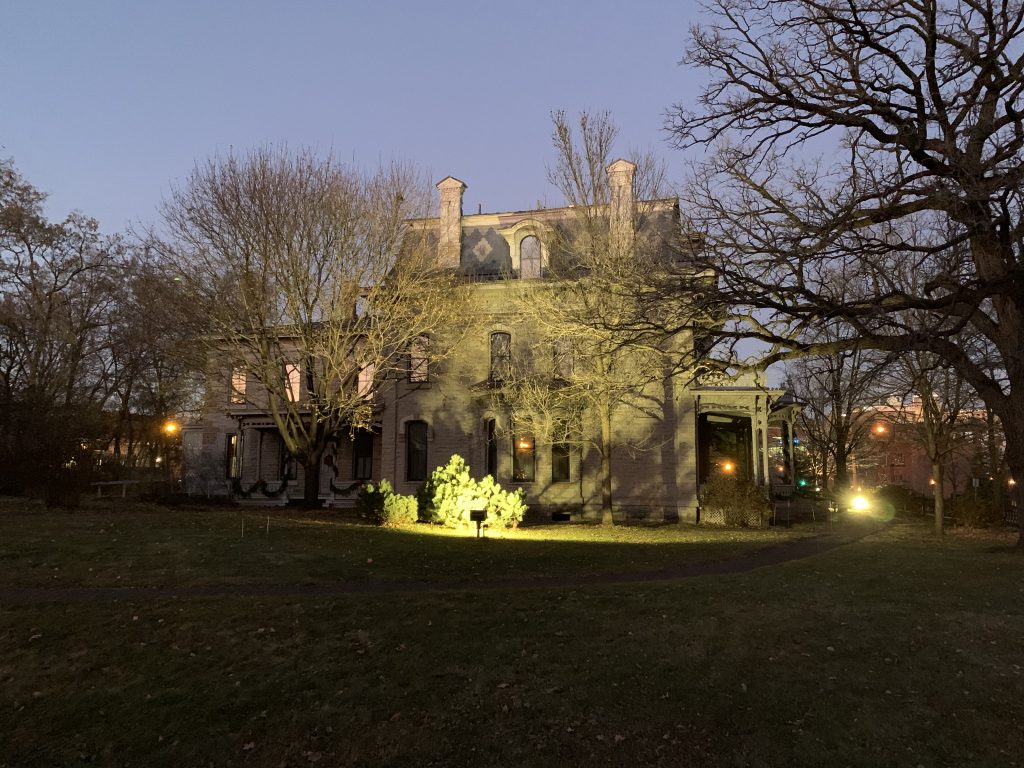
Southwest Face of the House 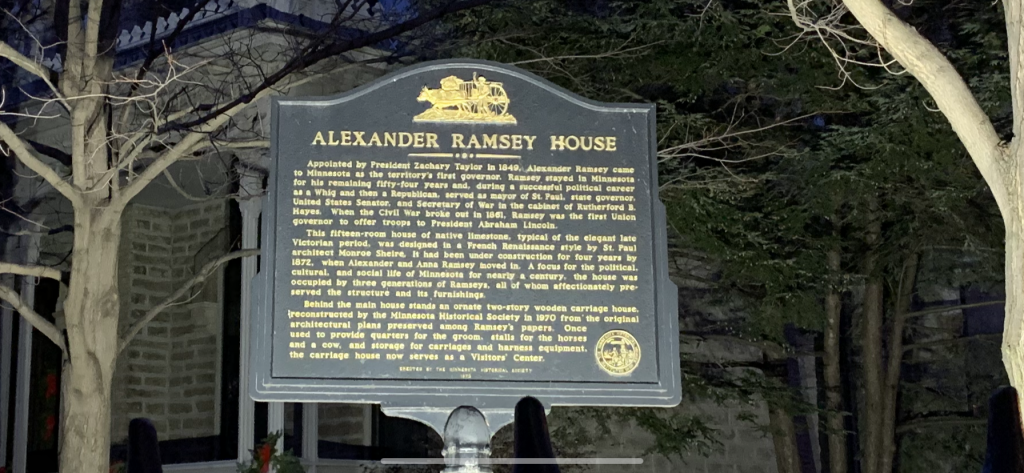
Plaque Nearby the House 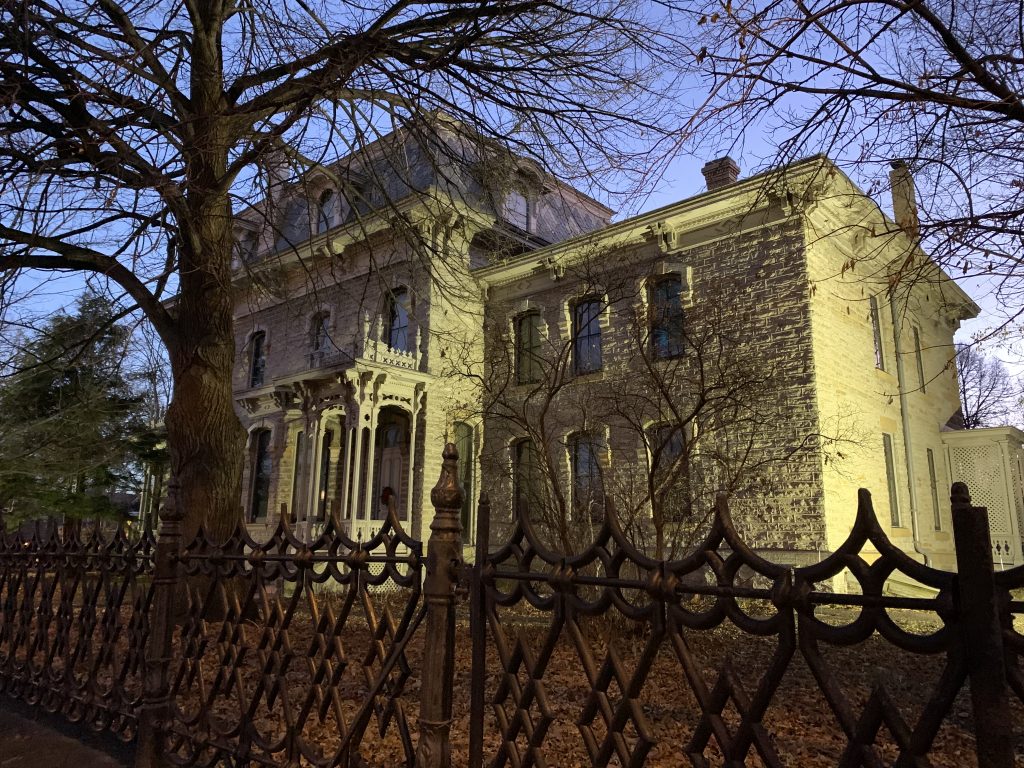
Northeast Face of the House 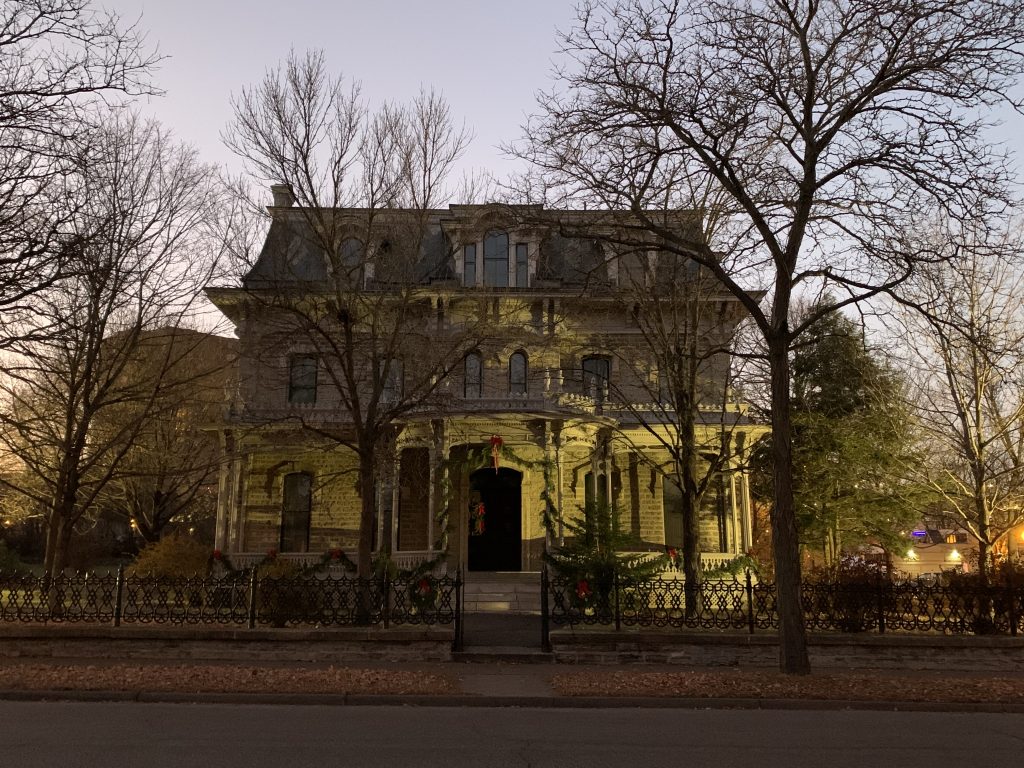
Front Face of the Alexander Ramsey as Seen from Exchange St.
Primary Sources
- Annual Report of the Commissioner of Indian Affairs to the Secretary of the Interior (1856-1857), United States. Bureau of Indian Affairs.
- Official Reports and Correspondence relating to the organization and services of Minnesota troops in the Civil and Indian Wars, 1861-1865, II. P. 1:
- Annual Message of Governor Ramsey to the Legislature (1862). Minnesota Legislative Reference Library.
- Alexander Ramsey to Abraham Lincoln, Friday,Telegram recommending expedition against the Indians. 1863. Abraham Lincoln papers: Series 1. General Correspondence. 1833 to 1916.
- “State’s Grand Old Man Dies,” (1903) St. Paul Globe 26.113: 1. [Newspaper] Retrieved from the Library of Congress.
Secondary Sources
- Marx Swanholm (1977). “Alexander Ramsey and the Politics of Survival,” Minnesota Historical Society. (Book)
- Ryland, William (1941). Alexander Ramsey: A Study of a Frontier Politician and the Transition of Minnesota from a Territory to a State. (Book)
- Haugland, John (1964). “Alexander Ramsey and the Birth of Party Politics in Minnesota,” Minnesota History 39.2: 37-48.
- Ackermann, Gertrude (1935). “Volunteer Guards in Minnesota,” Minnesota History 16.2: 166-177.
- “April, 1861: Minnesota Goes to War,” Minnesota History 37.5: 212-215
For Further Reading
- Alexander Ramsey (Wikipedia)

